Scattered across the northwestern coast are vast stretches of dead yellow-cedar trees, reduced to grey limbless spires after decades of decay. It is a heartbreaking sight to behold.
Such sights are commonplace along coastal areas of southern Alaska and northwest British Columbia, where these spectacular trees once thrived. The mortality event has been named “yellow-cedar decline,” but the underlying causes remain a mystery to this day. How is UBC Botanical Garden helping researchers like me to unravel this mystery?
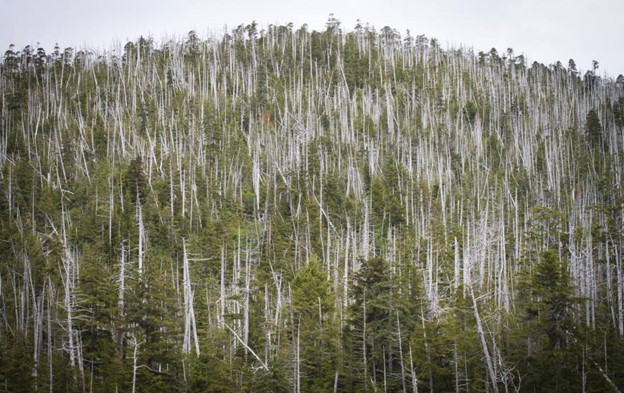
Yellow-cedar decline in Alaska. Photo by Lauren Oakes.
Decades of research on the decline have examined multiple possibilities: pests, diseases, competition from coexisting tree species — even deer grazing — and have since ruled each of these out as potential causes.
Subsequent research has proposed an entirely different explanation, one that implicates climate change and associated regional warming. Average wintertime temperatures have increased roughly 2-3 °C in many parts of northern B.C. and southern Alaska, leading to a transition from snow to rain and loss of snowpack along warmer coastal areas.
Snowpack acts as a thermal buffer which insulates soil temperature against changes in air temperature, preventing the soil from freezing or warming too rapidly.
Snowpack thus has two functions which are critical for the survival of yellow-cedars:
- It acts as a “protective blanket” which helps insulate the shallow root system typical of yellow-cedars from freezing temperatures;
- It prevents the soil from warming too quickly, which can induce premature root activity and increase the risk of freezing injuries resulting from spring frosts.
The exact nature of these injuries – specifically, whether freezing is outright killing the roots or leading to some other kind of physiological complication, and how such injuries compound to kill individual trees and ultimately entire populations – remains unclear.
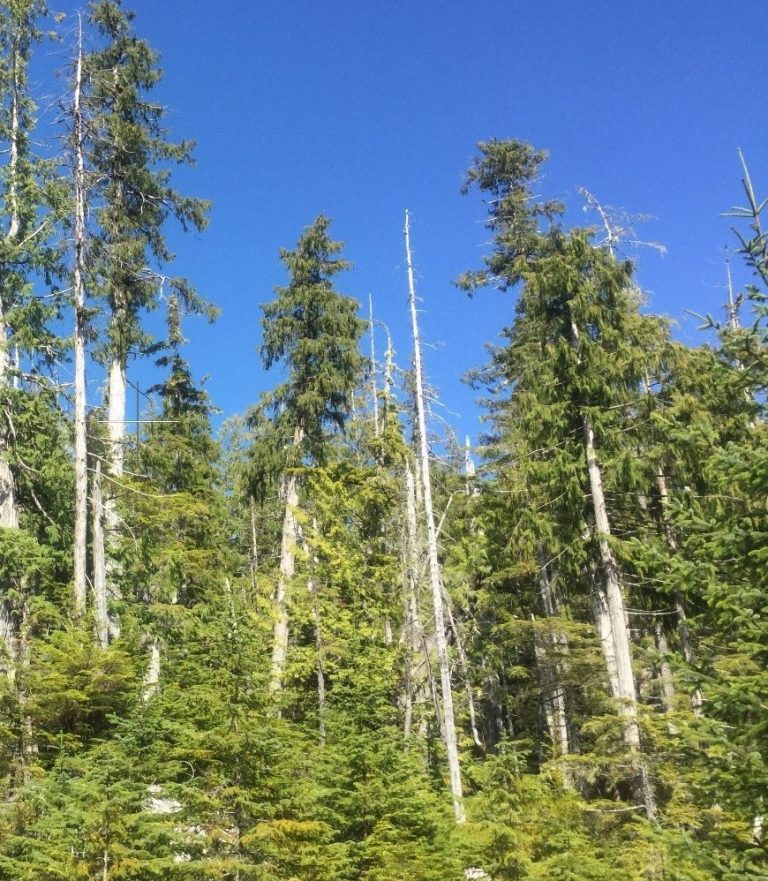
Yellow-cedar decline on the Haida Gwaii archipelago, British Columbia. Photo by Vanessa Comeau, a former graduate student in UBC Forestry and researcher of yellow-cedar decline.
Testing the Hypothesis of Freezing Tracheids
The first step to uncovering this mystery is determining exactly where ice formation is located, as freezing in some parts of the roots (e.g., living cells) carries a different set of consequences compared to freezing in other parts (e.g., tracheids, the non-living cells responsible for the transport of water and nutrients).
The current hypothesis states that the living parts of the roots are freezing, leading to massive tissue death which spreads from the roots to the aboveground organs.
An alternative hypothesis – one which we hope to test – is that the water inside non-living tracheids is freezing, leading to air blockages (or embolism formation) which prevent the transport of water and nutrients from the soil to the other parts of the tree. This is the same process that leads to formation of the tiny white air bubbles that appear in the ice cubes in a home freezer.
The critical difference between tracheid embolism and living cell death is the intensity and duration of the required freezing period: water in root tracheids has been shown to freeze at just under 0 °C, while most living cells in roots are cold-tolerant down to at least -5 °C. The likelihood of embolism formation is thus much higher than the likelihood of root cell death, especially among populations of yellow-cedars growing along mild, coastal regions, which rarely experience severe and prolonged frosts. Therefore, it appears more likely that embolism formation in the root tracheids is leading to yellow-cedar decline, rather than the death of living cells.
The likelihood of embolism formation has been shown to be most strongly related to the diameter of the central cavity of the tracheids, called “lumens.” Essentially, the wider the lumen, the easier it is to embolize, or fill with air. This is one reason why boreal and alpine regions, which experience frequent and intense frosts throughout the winter, are comprised almost entirely of coniferous trees with narrow lumens.
While there is a large amount of variation in lumen sizes between different types and species of trees, there is also considerable variation within each individual tree. Root lumens, in particular, are up to four times wider than those found in branch tips, a pattern observed in plants across the world.
Such tip-to-root widening is part of an adaptation to overcome the resistance associated with carrying water against gravity. Yet it could potentially have significant consequences for the formation of air embolisms, particularly in the case of yellow-cedar.
If yellow-cedars have wider root lumens than the species they coexist with, such as western red cedar and western hemlock, it could explain why the latter species are not experiencing decline despite experiencing similar climate disturbances as yellow-cedar.
Yet little is known about the lumen architecture of these species, which is where the UBC Botanical Garden has been a crucial resource for uncovering this mystery.
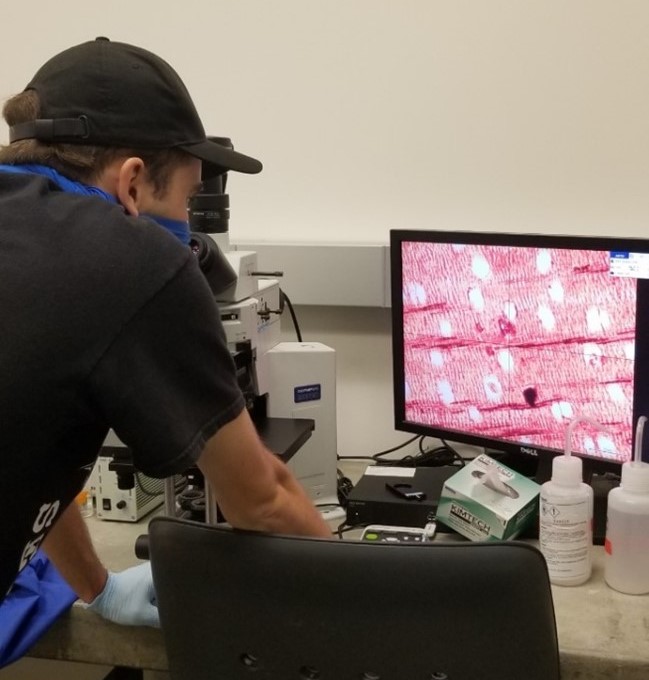
UBC Biology undergraduate student Brendan Hansen examining the cell anatomy of test samples collected at the Garden.
Sampling at the Garden
The UBC Botanical Garden contains many healthy and well-maintained yellow-cedars, redcedars, western hemlocks, and even a beautiful mountain hemlock in the BC Rainforest Garden. Such a treasured collection of trees has been indispensable for my research on yellow-cedar decline.
In May and June of 2021, I collected branch, stem, and root samples from a number of individuals belonging to these species, and I am currently conducting anatomical work to determine whether these species have distinct lumen architectures, and whether yellow-cedar architecture makes the species particularly vulnerable to freezing embolism.
My undergraduate assistant, Brendan Hansen, will be conducting additional analyses on other aspects of tracheid anatomy, including variation in wall thickness and the proportion of wall area to lumen area. Brendan has also provided crucial hands-on help during the collection process. I am hoping to publish the findings with Brendan as well as my advisor, Dr. Sean Michaletz, sometime later this year. Sean’s knowledge and support has been of paramount importance for this research, and I am very grateful for all of his help.
This work would not have been possible without the help from many fine folks at the UBC Botanical Garden. I would like to thank Daniel Mosquin, Patrick Lewis, and Andy Hill for helping get the various aspects of this research project approved.
I would also like to thank Ben Stormes for all of his hands-on help and for being an endless source of wisdom during the collection process. It was Ben’s idea to collect samples directly from the Greenheart TreeWalk, saving me much time and effort in avoiding climbing the trees to obtain canopy samples. I feel lucky and grateful to have had a chance to work with someone as skilled, resourceful, and kind as Ben.
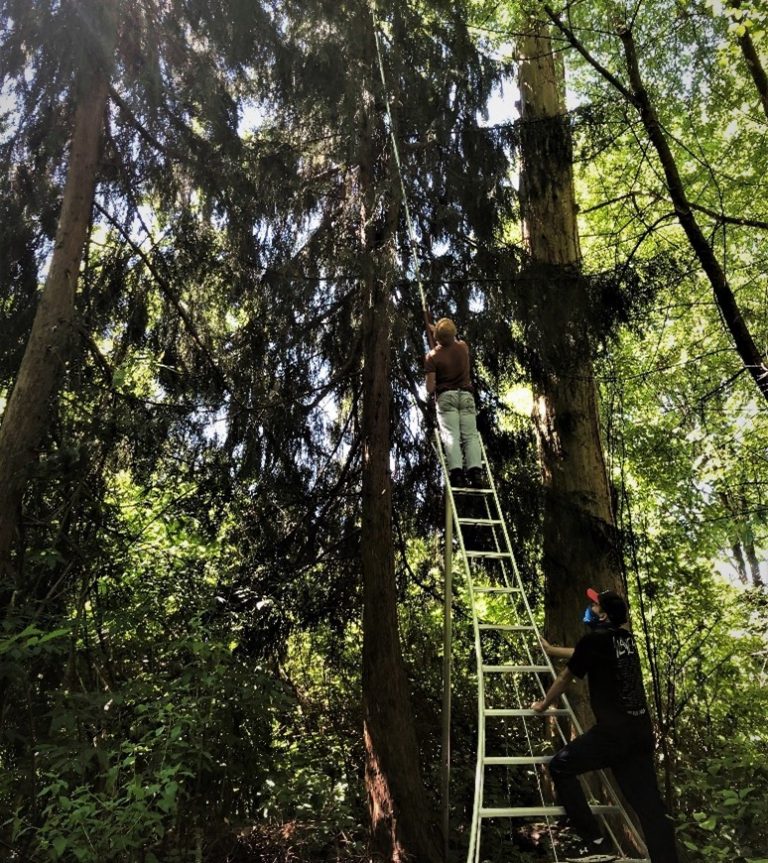
Milos and Brendan extract branch samples at UBC Botanical Garden. Photo by Ben Stormes, Curator, North American Gardens.

UBC Biology undergraduate student Brendan Hansen holding an increment borer and an extractor containing a red cedar core. Photo by Ben Stormes, Curator, North American Gardens.
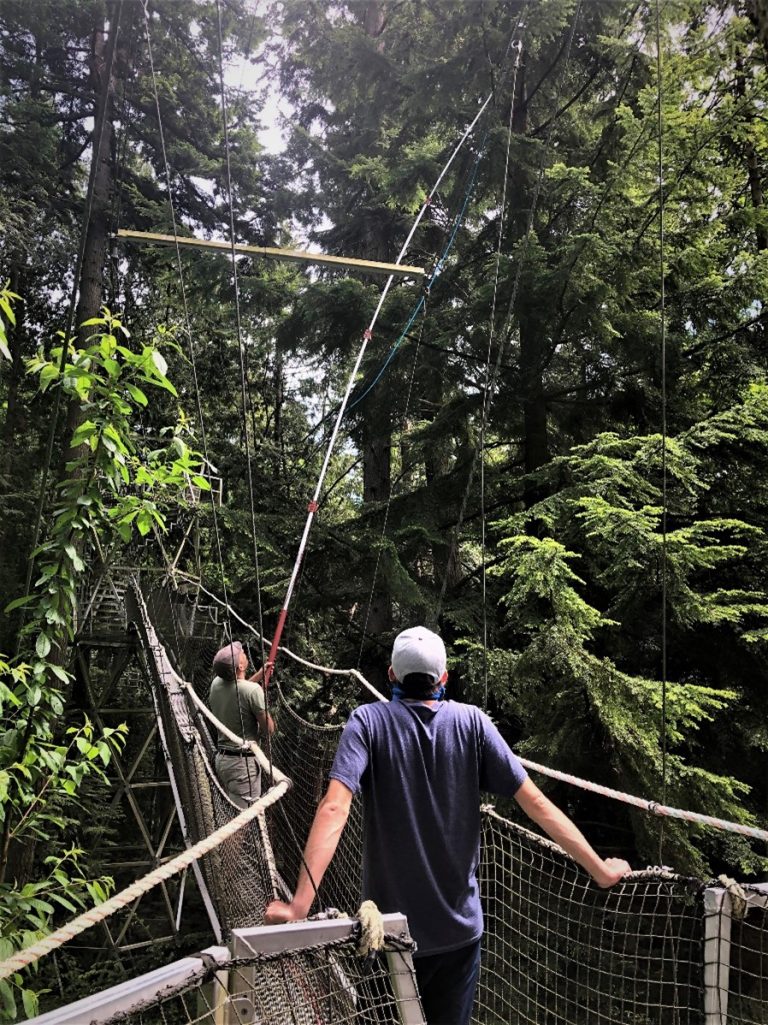
Milos and Brenden extract branch samples from the Greenheart TreeWalk. Photo by Ben Stormes, Curator, North American Gardens.
What Impact Will These Findings Have?
Should we find support for the alternative hypothesis, it would strengthen the theory that lumen architecture is the driving factor in the vulnerability to freezing embolism. It would have significant implications for the conservation of yellow-cedars growing in coastal southern Alaska and northwest British Columbia.
Assuming that yellow-cedars do in fact have wider root lumens than their neighboring species, such evidence would suggest that yellow-cedars are no longer adapted to grow and survive in these rapidly warming coastal areas. Thus, conservation efforts should likely focus on populations which are continuing to receive a robust wintertime snowpack, such as those growing at higher elevations.
Submitted by: Milos Simovic, PhD student in UBC Botany, Michaletz Lab
